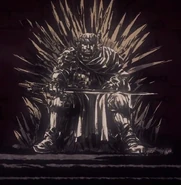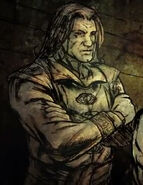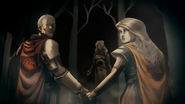No edit summary |
No edit summary |
||
| Line 19: | Line 19: | ||
| Father={[[Aegon I Targaryen]]} |
| Father={[[Aegon I Targaryen]]} |
||
| Mother={[[Visenya Targaryen]]} |
| Mother={[[Visenya Targaryen]]} |
||
| − | |Spouse = {[[Ceryse Hightower]]}<br>{[[Alys Harroway]]}<br>{[[Tyanna of the Tower]]}<br>{[[Elinor Costayne]]}<br>{[[Jeyne Westerling]]}<br>{[[Rhaena Targaryen]]} |
+ | |Spouse = {[[Ceryse Hightower]]}<br>{[[Alys Harroway]]}<br>{[[Tyanna of the Tower]]}<br>{[[Elinor Costayne]]}<br>{[[Jeyne Westerling]]}<br>{[[Rhaena Targaryen (daughter of Aenys)|Rhaena Targaryen]]} |
| Siblings={[[Aenys I Targaryen]]} <small>(half-brother)</small> |
| Siblings={[[Aenys I Targaryen]]} <small>(half-brother)</small> |
||
|Children={Numerous stillbirths} |
|Children={Numerous stillbirths} |
||
Revision as of 07:06, 29 December 2019
- "Aegon's own son, Maegor the Cruel, was killed by the very Iron Throne his father had forged. If you believe the tales. If you don't, then perhaps "The Cruel" is not a wise name for a king to earn."
- ―Varys
King Maegor I Targaryen, infamously dubbed Maegor the Cruel, was the third king of the Targaryen dynasty to sit on the Iron Throne. He was formally styled as Maegor of the House Targaryen, the First of His Name, King of the Andals and the First Men, Lord of the Seven Kingdoms, and Protector of the Realm.
Biography
Background
King Aegon the Conqueror had two children by his two sister-wives: his firstborn son Aenys with his sister Queen Rhaenys, and his second-born son Maegor with his sister Queen Visenya Targaryen. When Aegon I eventually died, Aenys succeeded him as the second king on the Iron Throne.
The Targaryens had incestuously married brother to sister for generations (whenever possible) to "keep the bloodline pure", in the custom of their Valyrian ancestors. For that matter, Aegon I broke not only the Faith's rules against incest, but its rules against polygamy, as he was married to both of his sisters at the same time.
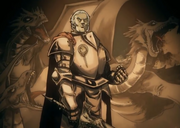
Maegor as Hand to his brother King Aenys.
The Faith wasn't in much position to challenge the victorious Targaryen army after the Conquest, or their massive dragons, but Aegon I was wise enough to tread lightly with the Faith: both sides tacitly agreed that the Targaryens' incestuous marriages were a relic of their past, which would soon fade. Aegon I didn't intend for future generations of his new dynasty to continue to have incestuous marriages, and in return, the Faith didn't press the matter for the remainder of his life. Aegon I eventually died and was succeeded by his elder son, Aenys.
To the surprise of all, however, later in his reign King Aenys tactlessly wed his daughter to his own son: the incestuous marriage of Princess Rhaena and Prince Aegon broke the Targaryens' prior promise to the Faith, which could stand the abomination no longer. The new High Septon led the denunciation of the Targaryens, and the military order of the Faith of the Seven, the Faith Militant, rose up in open revolt.[1]

Second secret wedding of Maegor was a provocation on Faith's eyes.
King Aenys proved to be an utter weakling in the face of the revolt and was completely overwhelmed. As the Faith Militant attacked lords that still supported him across the Seven Kingdoms, one particularly zealous force of the order even managed to scale the walls of the (still under construction) Red Keep, and would have killed Aenys and the royal family if not for the intervention of the Kingsguard. Frightened, Aenys fled King's Landing entirely and retreated to the Targaryen fortress-refuge at Dragonstone - where he soon died of cramps brought on from the stress.[1]
Reign
Aenys was then succeeded by his younger half-brother Maegor, Aegon I's only child by Visenya - seizing power ahead of Aenys's own children. Maegor was his brother's exact opposite: a highly skilled warrior and brutal tyrant, quickly earning him the name "Maegor the Cruel".[1]
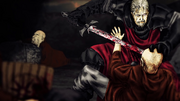
Maegor defeats the Faith Militant's champions in a bloody trial of seven.
King Maegor struck back against the Faith Militant. When he arrived in King's Landing his first act was to challenge their leaders to kill him in personal combat, if they believed his rule to be ungodly. The Faith accepted, and Ser Damon Morrigen proposed they hold a trial of seven - the more dangerous but theoretically more holy variant of a traditional trial by combat in which two teams of seven men fight each other. Many tales are told of their confrontation, Ser Damon and six of the Faith Militant against Maegor and members of his Kingsguard - but all the stories agree that at the end, out of all fourteen men only Maegor himself remained alive, proving that the throne was rightfully his.

Maegor uses Balerion to burn the Faith Militant chapter gathered at the Sept of Remembrance.
Having survived the trial of seven, Maegor promptly mounted the great black dragon Balerion - his father's old mount that Maegor mastered for himself upon his death - and flew it to the headquarters of the city's local chapter of the Faith Militant, at the Sept of Remembrance. Maegor used Balerion to burn down the sept and all who were inside while they were in the middle of the morning prayers. Hundreds of the Faith Militant burned to death, their screams echoing through the streets.[1]

Maegor's campaigns in the war led to purges in which thousands of the Faith Militant were killed.
Maegor now demanded the complete destruction of the Faith Militant, and made war upon the order wherever he found it. Yet the Faith Militant would not surrender, raising its own armies across the realm, and turning some of Maegor's own lords against him. Many battles were fought as the Faith Militant uprising dragged on for years, lasting throughout all of Maegor's reign.[1]
Maegor finished constructing the Red Keep during his reign, including the formidable central fortification which was named "Maegor's Holdfast" after him.[2][3] After the construction was finished, Maegor had all the workers and masons killed, reportedly in order that only he would know all of the secret tunnels he had them build hidden throughout the castle.[4]
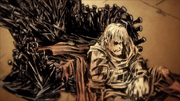
Maegor dead on the Iron Throne.
Eventually, Maegor's reign of terror came to an end when he died upon the Iron Throne itself. Maegor's cruelty died with him, however, as he was succeeded by Aenys's remaining son, who became King Jaehaerys I. A wise and benevolent ruler, Jaehaerys I made peace with the Faith in return for disbanding the Faith Militant, ending the uprisings. Jaehaerys's subsequent long reign did much to mend the wounds to the realm caused by Maegor.[1]
Season 1
While visiting the Great Hall of the Red Keep, Septa Mordane quizzes Sansa Stark on her history lessons, and asks her who built the structure and the Iron Throne. Sansa correctly responds that Aegon the Conqueror made the Iron Throne, and "Maegor the Cruel" built the Red Keep.[2]
Season 2
Wisdom Hallyne mentions that Maegor was a great patron of the Alchemists' Guild and their work producing wildfire, which he used against his enemies.[5]
Quotes
- Septa Mordane: "Do you remember your lessons? Who built the Iron Throne?"
- Sansa Stark: "Aegon the Conqueror."
- Septa Mordane: "And who built the Red Keep?"
- Sansa Stark: "Maegor the Cruel"
- — Septa Mordane quizzes Sansa Stark on the history of the Red Keep in front of the Iron Throne.[src]
- "The Substance is fire given form. And we have been perfecting it since the days of Maegor."
- ―Wisdom Hallyne recalls that Maegor was a great patron of the Alchemists' Guild and its production of wildfire.
- "Now people name Maegor "the Cruel", but I doubt any dared in his day. His strength was all too rare in the degenerate Targaryen blood. "
- ―Joffrey Baratheon expressing psychotic appreciation for Maegor the Cruel's brutality.
Image Gallery
Family tree
Template:House Targaryen family tree Conquest era
In the books
Background
In the A Song of Ice and Fire novels, Maegor was the second son of Aegon I Targaryen. His mother was Aegon's elder sister-wife Visenya Targaryen. He was the third king of the Targaryen dynasty - usurping the throne ahead of his half-brother Aenys's children - and is infamously remembered as a brutal tyrant.
Aegon I kept a mobile royal court, making royal progresses around his new realm to bind it together, and while the Red Keep was still under construction. Aegon kept Aenys with him as his heir, while Maegor was raised back at the ancestral Targaryen castle on Dragonstone. In time Maegor was commonly referred to as "the Prince of Dragonstone" - though at the time this was just a nickname, it became a by-word for his status as Aenys's presumed heir.
Maegor was a preternaturally skilled swordsman (not unlike the later Jaime Lannister), at the age of barely 12 he easily defeated squires five years older than himself. He was one of the youngest men ever knighted, at only 16 years old. In contrast, Aenys was physically frail and no great warrior, better suited to the comforts of court life and a patron of the arts. While Aenys wore fine silks at court, during his own reign Maegor most commonly wore armor, because he was constantly on military campaigns. When the two brothers were young, Aenys bonded with the dragon Quicksilver, one of the progeny of Aegon I's original three dragons. Maegor, however, refused to bond with any of the other half-dozen dragon hatchlings at the time, claiming none were worthy. Apparently, Maegor was holding out for his father's own mount, Balerion the Black Dread himself, the greatest living dragon - after Aegon I died of a stroke in his old age, Maegor successfully bonded with the great beast, and used him to devastating effect in crushing those who rebelled against the Iron Throne.
Aegon the Conqueror maintained a polygamous marriage with both of his sisters: Aenys's mother Rhaenys and Maegor's mother Visenya. Aegon himself always treated Aenys as his heir apparent because he was older than Maegor - though given young Aenys's frailty, there were some who muttered that Maegor should be his heir, given that he was his "firstborn" by Visenya - those who said this were chiefly Visenya herself, and her supporters, though Aegon I would hear none of it.
Aegon I was still wary of offending the Faith of the Seven, and promised them that his family's marriage practices of incest and polygamy - which the Faith considered abominations - were a relic of the past which they wouldn't continue in the future. To assure him of this, he had Aenys marry Alyssa Velaryon as a political match, who was mother to all of his children. Thus, the birth of Aenys's own children pushed Maegor even further back in the line of succession, as by the normal laws of Westeros an uncle only inherits after his elder brother's entire bloodline is extinguished.
Maegor's mother Visenya didn't give up on her ambitions in court politics, however, pushing for Maegor to one day succeed ahead of Aenys. Thus when Aenys's first child was born, his daughter Rhaena, Visenya urged Aegon I to betroth her to her Maegor, her own half-uncle. Aegon I, however, dismissed the suggestion - both because he didn't want to risk offending the Faith with such an incestuous marriage, and (it is believed) because he had become frustrated with Visenya's constant attempts to usurp Rhaenys's son Aenys with her own. To further appease the High Septon, Aegon made Maegor marry Ceryse of House Hightower - the High Septon's own niece. As the years passed Maegor failed to produce any heir, and there were fears that he was sterile - causing him to lose supporters, who didn't think it was worth upsetting Aegon I's intended succession for an heir who couldn't continue the family line anyway.
After their father Aegon I died from a stroke in old age (in 37 AC), Aenys succeeded to the throne. Four separate localized rebellions immediately broke out trying to seize on the opportunity of what they perceived as Aegon's weak successor: in the Iron Islands, at Harrenhal, at the Eyrie, and the "Vulture King" leading a bandit army in the Red Mountains along the border with Dorne. Their bastard uncle Orys Baratheon died from his wounds successfully putting down the insurrection in Dorne, and the current Hand of the King died putting down the rebels at Harrenhal, while Maegor used Balerion to successfully crush the rebels in the Vale. When the rebel lords heard Maegor and Balerion were coming, they surrendered without a fight and executed their ringleader Jonos Arryn (who had overthrown and killed his own brother Ronnel to seize power) by throwing him out of the Moon Door. They hoped that their surrender might gain them mercy, but Maegor ordered them all hanged regardless.
As a reward for his success in handling the rebellion in the Vale, Aenys named Maegor to fill the vacant office as his new Hand of the King. With Aegon I, Rhaenys, and now Orys dead, Dowager Queen Visenya became the last of the Conquest-generation of Targaryens, and she did much to aid her son Maegor's rise in power. Aenys even gave Maegor the ancestral Valyrian steel sword of House Targaryen, Blackfyre, which had been carried by their father - openly acknowledging that Maegor was a better warrior than he ever was. For a brief two years, the two brothers ruled the realm together in peace.
Yet Maegor grew increasingly frustrated with his childless marriage, as Aenys continued to produce more heirs of his own to push him far down in line of succession, and the High Septon would never grant Maegor a separation from his own niece Ceryse. Eventually, two years into Aenys's reign Maegor polygamously took a second wife, Alys of House Harroway (the ceremony performed by Visenya, as no septon was willing to perform it). This angered the Faith so much that Aenys had to strip him off his office and exile him to Pentos. Aenys then announced that he was making "Prince of Dragonstone" the official title of the designated heir to the throne - and that he was bestowing it on his son Prince Aegon, to dispel any lingering sentiments that Maegor was his direct heir ahead of his own children.
With Maegor gone, there was no pragmatic restraint on Aenys's poor decisions. Despite an already strained relationship with the Faith, two years later Aenys foolishly announced the marriage of his daughter and eldest child Rhaena to his eldest son Aegon, directly sparking the Faith Militant uprising. Aenys was physically and emotionally overwhelmed by the rebellion, and fled King's Landing entirely to withdraw to Dragonstone, where he became nearly catatonic and is said to have died of cramps brought on by the stress (though many suspect that Visenya poisoned him). Whatever the case, barely an hour after Aenys's body was cremated, Visenya flew to Pentos on Vhagar to retrieve Maegor, who flew back with her to Westeros riding Balerion.
Reign
Upon his return to Dragonstone in 42 AC, Maegor was immediately crowned king - usurping the throne ahead of Aenys's five children. Rather than wear Aenys's ostentatiously large gold crown, Maegor wore his father Aegon I's own crown - a circlet of Valyrian steel with seven cut rubies set in it - symbolically asserting his status as his father's true heir (now possessing his father's crown, sword, and dragon). Grand Maester Gawen was the only one to openly protest, pointing out that Aenys had three sons (Aegon, Viserys, and Jaehaerys) and by every inheritance law in Westeros, Maegor was behind them in line of succession. Maegor responded by beheading Gawen with a single swing of Blackfyre, and no one else spoke a word against him - many feeling that Aenys's young children could not handle the Faith Militant as Maegor could. He retook King's Landing, won a trial by seven with the Faith Militant, then burned the Sept of Remembrance using Balerion to wipe out their King's Landing chapter at a single stroke. An army of the Faith Militant was slaughtered at Bitterbridge, and an even greater battle was fought at the Great Fork of the Gods Eye, with Maegor riding Balerion during a great rainstorm - this battle was bloody but decisive, with Maegor wiping out the opposing force.
Nonetheless, uprisings continued in similar though usually smaller scale flashpoints for the next six years: Maegor would always succeed in destroying the Faith Militant's armies when they marched openly against him, but he would still end up losing men and resources to attrition, and before long more new converts to the Faith Militant would pop up again in another part of the realm far away from where his main armies had currently moved. Also, when Maegor returned from the Free Cities in 42 AC he brought with him a new, third polygamous wife, called Tyanna of Pentos - rumored to be a sorceress and poisoner. Maegor appointed her as his new Mistress of Whisperers, and she became greatly feared.
In 43 AC, Aenys's son and heir Prince Aegon (who had managed to avoid capture), led his own revolt against Maegor to claim the throne that was rightfully his. This was not technically considered to be part of the Faith Militant uprising, however, because the Faith was also particularly upset about Aegon's incestuous marriage to his own sister. Prince Aegon was the new rider of his father's dragon, Quicksilver, by this time over 30 years old and a full-grown adult beast. Rebel lords rallied around Prince Aegon and his dragon, and they clashed with Maegor and his army in the great Battle Beneath the Gods Eye. Prince Aegon rode Quicksilver into battle against Maegor riding Balerion - the first time two dragons had fought each other since before the Doom of Valyria. Quicksilver, however, had no hope of defeating the older and larger Balerion, then at the height of his power and majesty: both Prince Aegon and his dragon died in the battle.
In 44 AC, the High Septon who initiated the uprising suddenly died - many suspect he was poisoned by Maegor's agents. He was replaced by a new High Septon who was Maegor's puppet, but the Faith Militant refused to surrender and the fighting continued. Also in 44 AC Dowager Queen Visenya died, last of the Conquest generation of Targaryens, and Maegor's greatest supporter throughout his life. He actually seemed to take her death in stride, but Aenys's widow Alyssa Velaryon - who had been held prisoner on Dragonstone - used the confusion of Visenya's death to escape, along with her two youngest children, Jaehaerys and Alysanne, and Visenya's own sword Dark Sister. Aenys's middle son Viserys was being held hostage at the Red Keep, however, and when Maegor found out about Alyssa's escape he had him tortured to death and his body left to rot in the courtyard (trying to lure Alyssa back to demand a proper funeral, but she didn't take the bait). In 45 AC Maegor launched into a new major campaign, which resulted in him taking the skulls of 2,000 men of the Faith Militant as trophies.
Maegor's supporters, however, grew increasingly unsettled at such open brutality. By this point his mental state was becoming increasingly unhinged (even relative to his prior actions), because none of his wives could produce him an heir - many whispering that he could not continue the Targaryen dynasty on his own. In 47 AC he forcibly wed three women in a triple marriage ceremony (for a total of six concurrent wives). These three "Black Brides" were all the widows of men he had killed in his wars, of proven fertility because they already had children - among them his own half-niece Rhaena. Even then, his wives only bore him stillborn monsters, each of which greatly distressed him, and he descended into genuine madness. The first of these stillborn abominations was produced in 48 AC, to his second wife Alys Harroway of Harrenhal: his third wife Tyanna of Pentos convinced him that it was the product of an affair Alys had, so Maegor executed Alys, her midwives, the Grand Maester, and every member of House Harroway, exterminating it. Eventually, however, Tyanna was somehow made to confess that she had actually used poison (and possibly sorcery) to produce the stillbirths in Maegor's other wives - at which he cut out her living heart with Blackfyre, and threw it to his dogs.
At this point the realm could tolerate Maegor's behavior no longer. Later that same year in 48 AC a new army of the Faith Militant organized, and rebel lords rallied around the fugitive Prince Jaehaerys. Maegor's own Master of Ships Daemon Velaryon left to side with the rebels, at which all of the other great lords of the realm abandoned him in short order - among them even his former close supporters like the Baratheons and even the Tullys (who had fought against Prince Aegon for him not long before).
When Maegor called on any remaining loyal lords to come to his aid, no armies came - even two of the Kingsguard abandoned him to join the growing rebel army as it advanced on King's Landing. It was only a matter of time until they reached the defenseless city. Maegor was found dead in the morning, sitting on the Iron Throne itself. The histories do not confirm exactly how he died: in some versions of the tale, he was murdered by the Iron Throne, while others suspect he was poisoned. Historians consider the most likely scenario that as Maegor sat despondently on the Iron Throne in an empty hall late at night, simply waiting for the hours to pass until the rebel army came to take the city, he looked down at the still-sharp blades that made up the Iron Throne and - resolving never to be taken alive - slit open his own wrists on the throne itself, and bled to death.
Maegor's reign of terror at an end, Aenys's rightful heir Jaehaerys was restored to the throne, ushering in an 80 year golden age for the Targaryen dynasty.
Legacy
One of the steps that Maegor took to combat the Faith Militant was to declare it illegal for holy men to carry weapons, demanding that the order disband. Jaehaerys wisely negotiated a peace with the Faith by granting an amnesty to all surviving members of the Faith Militant if they would only lay down their arms and disband, and in return the crown would swear to always defend the Faith. "Maegor's laws" forbidding holy men from carrying weapons remained in force up until the War of the Five Kings, when Cersei Lannister shortsightedly rescinded them to allow the Faith Militant to be re-created.
While Maegor was an infamously ruthless man, he was not necessarily considered to be "medically insane", the way that many later Targaryens became insane due to generations of incestuously marrying brother to sister to "keep the bloodlines pure" - in the sense that he did not suffer from hallucinations. Nonetheless he was always a brutal, ruthless man with strong sociopathic tendencies: meting out disproportionate retribution against his enemies (exterminating entire family lines if a single member failed him), and showing cruelty to animals (as a boy he killed a horse in its stable because it had kicked him). It doesn't seem that he outright enjoyed inflicting torment on random people (as the later Joffrey Baratheon did), but he would cruelly punish anyone who opposed him - and as his reign of terror spiraled out of control, his wrath led him to crush his subjects over minor slights or failures. His only response to any threat was to react with brutal force, which caused more people to turn against him in horror, which enraged him to punish them with even more brutal force, turning even more people against him, in a vicious cycle. In the last year of his reign, as his wives produced only deformed stillbirths, and more of his former allies turned against him, the stress did cause Maegor to spiral into an emotional state of near-madness and delusion.
In later generations, Maegor was remembered as the proverbial tyrannical king to the people of the Seven Kingdoms: any time another potential ruler appeared brutal or tyrannical, it was whispered that they would be "the next Maegor the Cruel". This only stopped in the last generation, when Aerys II "the Mad King" terrorized the realm, ultimately leading to his downfall in Robert's Rebellion - after which the proverb shifted to saying "he would be the next Mad King", or when Tyrion remarks that Joffrey is on his way to becoming "Aerys the Third". Maegor was so controversial that even two and a half centuries later he is still best remembered as "Maegor the Cruel", and later generations of the Targaryen dynasty were tactful enough never to name one of their sons "Maegor" again (except for the mad Prince Aerion the Monstrous).
See also
References
Template:Targaryen navbox Template:Kings of Westeros navbox


